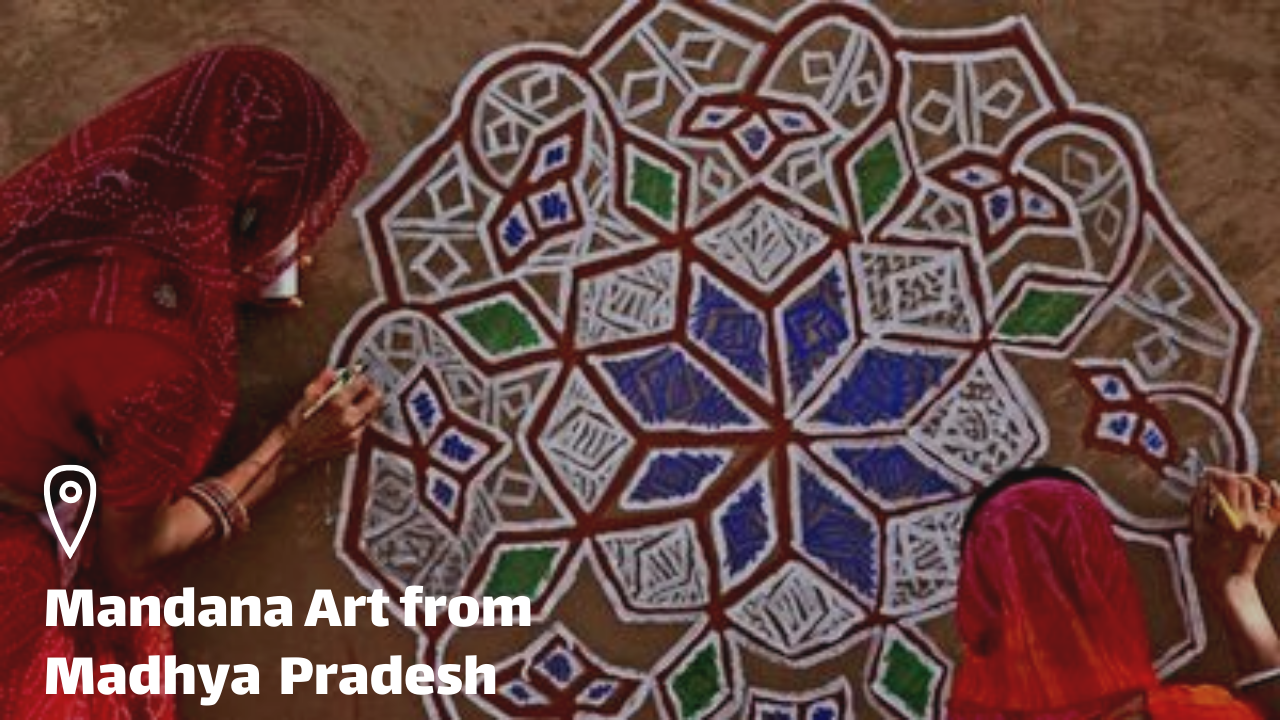Madhya Pradesh has countless attractions to offer to the tourists – forts, palaces, Hindu temples, Jain temples, mosques, most delicious diversity of food, art, and culture. In this article, we bring to limelight one of its most valuable offerings Mandana Art.
Mandana paintings are the wall and floor paintings traditionally done in Rajasthan and Madhya Pradesh, India. They are painted in homes to protect them, to draw health and wealth, to welcome gods into the house, for celebrations on festive occasions, etc. Similar paintings are also created in the most of the parts of Nepal and are called Mandala.
In Madhya Pradesh, the art is mostly used to decorate floors while in Rajasthan it is used both on walls and floors. The Village women in the Sawai Madhopur area of Rajasthan are known to possess the skill for developing simplistic designs to perfect symmetry and accuracy. The art has its roots in one of the oldest tribal communities of India, Meenas.
The word ‘Mandana’ in local languages means decoration, or more exactly, beautification. The resultant drawings are called Chitra Mandana – ‘Chitra’ here simply means drawing or painting.
The creation
The Mandana art can only be created on clay walls or floor. The ground that is to act as the canvas for Mandana art is first prepared with a mixture of cow dung, rati (which is a local clay), and red ochre. Lime and/or chalk powder is used for making the motif. The other tools used are a piece of cotton, a tuft of hair and/or a rudimentary brush which is made out of a date stick.
The Motifs
The motifs of the design include Lord Ganesha, peacocks, women at work, tigers, floral motifs, etc. Peacocks are the most frequently occurring and, one might claim, the signature motif of these works.
This love for repetition of these simple motifs, that seem to stand by themselves without trying to narrate any stories, puts in one’s mind Carl Gustav’s Jung’s theory and ideas about archetypes and archetypal symbols.
That said, it is not to say that Mandana art is closed to innovations. Over the years, the artists have introduced several new motifs – tractor, bus, bullock-cart, cycle, motorcycle, etc.
The simplicity of the motifs is also visible in the scheme of colors which are used to fill the drawings as the last step in completing the work. Normally as few as two colors are used – often red and white.
In some of them like tapki Ke Mandanas, the motifs are placed in a way to form a geometrical shape – a rhombus, a circle or a rectangle. This love for geometrically perfect shapes is once again something a Jungian could smile at.
Importance during festivals
The motifs are associated with good luck and are thus called ‘Shubh Manglik’ and survive in some regions only in celebration of some of the festivals. Teej is a semi-popular festival that often involves the use of Mandana art or some rudimentary form of it. Another popular example in which it survives is ‘rangoli’.
A dying art
Mandana art is dying and the artists are finding less and less employment even within villages as the number of concrete houses is on the increase and concrete is not receptive to this art which can only be created on walls of clay and anyway there are fewer takers of the art as it is.
There are many reasons to save this art. Its creation combines two qualities that rarely go together in most modern arts – simplicity and beauty.
Again, its use of natural material as its tools speaks highly of how eco-friendly our traditions were – and not to say inexpensive.
It is also a source of traditional employment for women in a country and community where employment for women was very rarely encouraged traditionally. There is something feminine about the aesthetic of the work itself. You won’t see a lot of warrior men in the works, for example; and motifs like peacocks and flowers are so much more attractive to women.
And the paintings no matter how simple is never without a part of the artist’s soul in it. A part of the artist’s life – and that of the artists that previously did the same work is contained in those works – telling us of their lives and experiences. The simplicity of such art forms as Mandana can be deceiving and might make an outsider consider it to bo be devoid of meaning when the very opposite is the truth.
Mandana art in new platforms
The Mandana art might be getting exiled from its home of centuries – the walls and floors of houses but it has found newer places to exist. One such place is the canvas. More and more painters are being inspired by Mandana art and streaming their art through the centuries-long language of expression developed over centuries by Mandana artists.
Another place it is getting its foothold on is fabrics. The traditional designs and artworks are increasingly getting trendy, thus giving a new place for Mandana art to survive.
Conclusion
We hope that Mandana art manages to find survivors in these forms if not in its traditional art. If you love the mesmerizing simplicity with which they strike one, please do consider buying some Mandana art worked goods and let us hope the art regains its old popularity. Cheers. J
